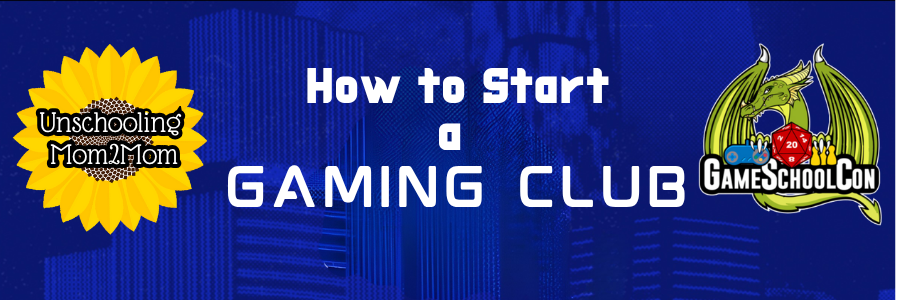How to Start a Gaming Club: Building Community Through Play
There’s a persistent myth that games are isolating, that players sit alone in dark rooms staring at screens. But games have always been about
connection. Whether it’s laughing over a board game, teaming up in Minecraft, or swapping stories about your latest D&D campaign, play creates powerful social bonds.
This post was created in collaboration with GameSchoolCon, a weekend-long celebration of learning through play, where gaming families, homeschoolers, and curious learners come together to connect, discover new games, and build community through shared play. This is part of a two-part series of blogs about gaming clubs and community.
On Unschooling Mom2Mom, we are covering
how
to start a club.
On GameSchoolCon, we are covering
why gaming clubs are a good idea and how games create community.
Starting a gaming club gives everyone a space to share their interests, make friends, and build confidence in social interactions. This blog post walks you through, step by step, how to create your own gaming club, no matter the form it takes.
When we value what lights them up, we show them that their choices matter.
And then we help them figure out how to make it work!
~Sue Patterson
Step 1: Define Your Club’s Focus
The first step is deciding what kind of games your club will feature. A “gaming club” can mean many things, from board games to tabletop games to video games and more. What’s important is to pick a focus that you're passionate about and understand well enough to help others.
Board Game Club:
- Pros
- Great for all ages, especially younger kids.
- Easy to run, with minimal need to accommodate different skill levels due to the constant rotation of games.
- Offers lots of face-to-face interaction.
- Cons
- Takes up space with an extensive collection of board games and other items, unless you stick to a few games.
- Everyone starts fresh, so be prepared to explain the rules.
- Pros
- Easy to coordinate online.
- Cooperative games encourage teamwork, and competitive games encourage mutual improvement.
- Digital focus means that every game fits on one device.
- Cons
- In-person gaming clubs may need to haul heavy equipment to play.
- Video games and consoles are expensive.
Tabletop Roleplaying Club (like Dungeons & Dragons):
- Pros
- Builds creativity, storytelling, and collaboration.
- A hit with teens who love world-building and imagination.
- The imaginative nature lets you play with extremely minimal tools and equipment.
- Cons
- Tabletop RPGs are very hard, testing literacy, math, and awareness skills, making them hard for younger kids.
- High learning curve; it might take unfamiliar players a while to understand.
Trading Card Game (TCG) Club:
- Pros
- Multiple ways to engage allow people to come to collect, trade, and compete.
- Every person brings their own tools to play (cards), rather than needing to do it all themselves.
- Collecting and trading gives a physical reminder of your time spent with others.
- Cons
- If someone lacks cards, they are unable to play and engage without borrowing some.
- Much harder to capture the same fun online without the ability to trade and collect physical cards.
These are just a few examples, but you do not have to bind yourself to any one format. If you know what your community is looking for, a mixed-media club that engages with different types of games might also work. It’s up to you to define your focus.
If you’re starting a club at a school, library, or community center, consider the space, access to technology, and the size of your group. Keep in mind that younger kids may prefer simpler, fast-paced games, while teens often enjoy longer sessions and games that test their skills and knowledge.
Step 2: Find Your Space and Support
A gaming club doesn’t have to be fancy, but having a consistent meeting place makes all the difference. Look for options such as:
- Local libraries or community centers
- Game stores (many are open to hosting free community events)
- Someone’s home or garage with space for tables and chairs
If you’re working with minors, make sure there’s always adult supervision and that the environment is safe and welcoming. Post clear expectations about kindness, inclusivity, and respect, the heart of every great game group. Snacks always go a long way, too!
Step 3: Invite Members (Even if You’re Shy)
Starting a club can feel intimidating, especially for teens who already deal with
social anxiety.
But remember,
everyone there shares your interests.
That’s the magic of games. They give you built-in icebreakers.
Try one or more of these approaches to get started:
- Ask around. Tell friends, classmates, or parents you’re starting a gaming club and see who’s interested.
- Make a flyer or social media post. Include meeting time, location, and what kinds of games you’ll play.
- Start small. Even three or four people are enough to begin playing. Those people might invite others to play, expanding your club.
If you’re anxious about reaching out, start by connecting online, such as a small Discord server or group chat for your area. You can transition to in-person meetups when people feel ready.
Step 4: Find Your Equipment
“Equipment” in this context is a catch-all term for any items needed for your club to function. While we cannot cover every type of equipment, as that will change based on your club's focus and what the venue offers. Here are some broad categories to look out for when selecting your equipment.
- Furniture and Venue Items
- Depending on the venue, you might have to provide your own tables, chairs, and other items to make the space around your club comfortable for play.
- For gaming clubs with electronic devices, make sure to bring the tools to set up those devices, like extension cords for plugs and charging cables to allow people to charge their own devices
- Games
- The games you bring can take many different forms. (See: Step 2) A board game club can be as simple as bringing 1 new game each week, or multiple games to enable group play.
- You can also encourage others to bring games they want to play to the venue, which will reduce your workload.
- Electronic Devices (Phones, Computers, Laptops, Consoles, etc.)
- For many types of gaming clubs, having a fair share of electronic devices is critical for play. The amount and type of devices depend on your focus and scope. For example, a video game club might want to have multiple consoles and monitors so multiple people can play at a time.
- People can also bring their own devices as well, usually smaller devices like laptops and phones can enable group play, just make sure to provide outlets and chargers!
- Snacks and Refreshments
- Not a requirement, but gaming can be exhausting, and many kids don't have the time to eat beforehand.
- Snacks can be a bonding experience, especially if people bring their own.
- Refreshments (at least water) are crucial to staying healthy in long play sessions; nobody wants to be dehydrated hour 3 into a game of Monopoly after all.
Step 5: Keep It Consistent (and Welcoming)
Once you’ve picked your games and started, consistency is key. Choose a regular meeting time, weekly, bi-weekly, or even monthly, and stick to it. That reliability helps friendships grow.
Encourage members to:
- Bring their favorite games to share
- Take turns teaching or hosting
- Respect each other’s comfort levels (some players prefer observing before joining in)
- Celebrate small wins and teamwork
For teens especially, a gaming club can become a safe, social anchor, a place where showing up feels easy and belonging happens naturally.
Step 6: Be Patient and Persistent
At first, your club might feel small. Maybe only a few people show up, or a meeting feels a little awkward. That’s completely normal. Every great community starts with persistence and patience.
Give your club time to grow. Word of mouth spreads slowly at first, then all at once. Celebrate each new person who joins, even if it’s just one at a time. And don’t shame people for leaving, or taking breaks and coming back. Keep showing up, keep inviting others, and keep creating an atmosphere where everyone feels welcome. You are the role model for the rest of the club.
Building a club isn’t about instant gratification. It’s about consistency, showing that you mean it when you say “everyone’s invited.” And even a small club can be a success in building connections that will stick with you and/or your kids for a lifetime.
Why Gaming Clubs Matter
For many kids and teens, gaming clubs are more than a hobby. They’re a lifeline. They offer a place to belong, express creativity, and connect without the pressure of traditional social settings.
Games naturally foster discussion, shared passion, and time spent together, three ingredients that make friendships stick. Whether you’re rolling dice, building in Minecraft, or solving puzzles side by side, you’re not just playing games; you’re building community.
Want to Keep the Momentum Going?
If your family loves learning through play, check out GameSchoolCon, a one-of-a-kind event where families connect over games, roleplaying, workshops, and community. You’ll find people who believe, just like you, that play is one of the most powerful ways to learn and grow.
Written by Alex Cook for GameSchoolCon. Alex is a grown unschooler, writer, and speaker. He’s a senior in college studying Strategic Communications and loves exploring how games, media, and storytelling shape the way we connect and learn.










